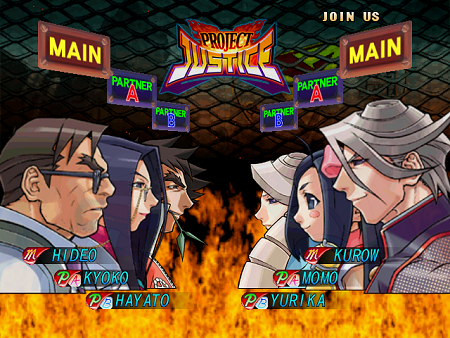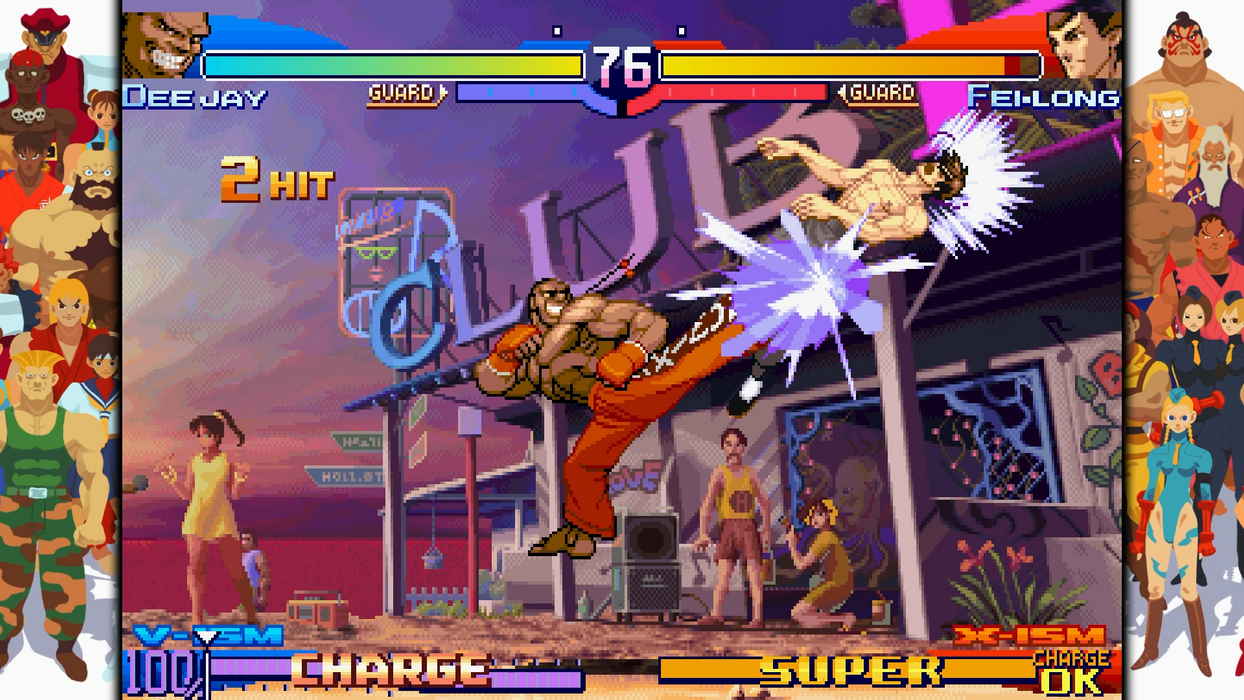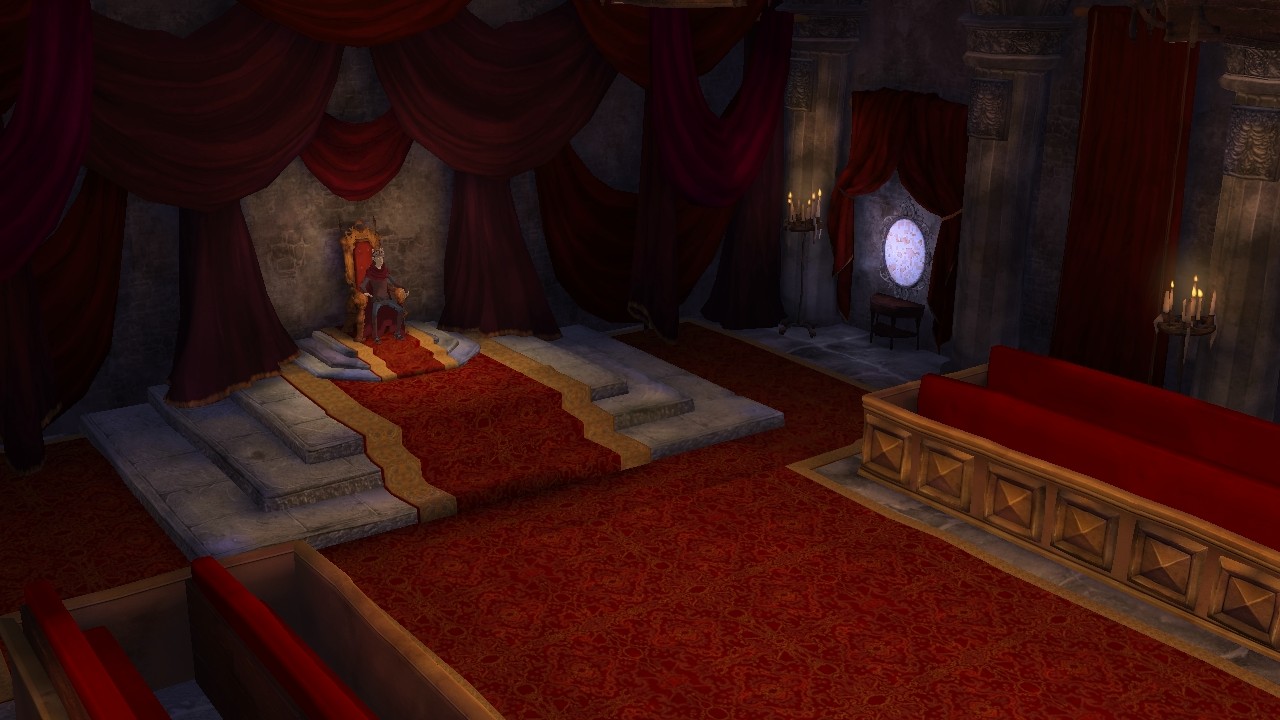With Fatal Fury: City of the Wolves happily promoting a
well-known potential rapist and tax evader, Capcom Fighting Collection 2 was my
most anticipated game of the year and a huge deal for fighting games on the
whole. Just think that in the old days, having
one of the games on a console was worth 50 dollars each and now they’re all in
one place for 40 dollars. Those games on
consoles have had varying degrees of inaccessibility over the years, with one
in particular being virtually impossible to play until now.
This new collection also means that it’s time for another
addendum in this blog’s documented battle between SNK and Capcom. Until this collection I couldn’t take Plasma
Sword, Project Justice, Street Fighter Alpha 3 Upper or the first Capcom vs. SNK
into consideration, but now just like with the Marvel Collection, that will be amended
and Capcom will have the chance to break the tie and be the king of
arcades. I will still be going over the
games I’ve already looked at as well to judge any subtle differences between
the versions featured in this collection and the ports I played before.
I will also briefly explain just how difficult it was to
play these games before this collection because I can’t emphasize that
difficulty enough. With the sole exception
of the Punisher game, the games in the Marvel vs. Capcom collections were
widely distributed and can still be found in retro arcades or had digital
re-releases before Disney tore it all down.
These though? No way in hell. What
few games in this collection I’ve seen in arcades before now I’ve only seen
once.
Capcom vs. SNK 2
TheSince this collection also includes all of the characters added
in the EO console version, there’s no longer a need to get the Gamecube
version. That version does have some fun
features in the form of custom grooves, color edit and the titular Easy
Operations mode that lets you throw punches and kicks using the
pressure-sensitive Gamecube controller in a throwback to the very first Street
Fighter. However, the core game’s
content is all in this collection and that’s all I really need. Remember that the Gamecube version of CVS2
can cost the same as this whole collection and it’s just one of several games
on it. It almost makes me want to weep
with joy.
The Power Stone Duology
The big advantage of playing the games on this collection is
that now you can play locally without needing another PSP and you can play
online, making the fun multiplayer they were made for much easier. I’m happy they’re included in this collection
for more people without PSPs to enjoy, but if you really like them, are going
to enjoy them on your own time and want to get the most out of the Power Stone
franchise, definitely get the Power Stone Collection for 10 dollars off of PSN.
Capcom Fighting Evolution
Yeah this game is still laughably pathetic. The option to change the internal resolution
makes the game’s admittedly good character artwork look better, but I think it
makes the crappy-looking backgrounds even worse because you can see even more
clearly how much in them is copy/pasted and blurry.
The collection throws it a bone by adding a nostalgia remix
music track option. Instead of whole new
compositions like CVS2 and Power Stone 2 got, this second soundtrack changes
the music to each character’s corresponding theme, with Chun-Li’s being her
Third Strike theme because she’s in the Street Fighter 3 category. It’s a cool option to put the focus of the
audio on the characters rather than the stages to emphasize the crossover
aspect, and it’s a better alternative to the forgettable music of the actual
game, but the game itself is still Capcom Fighting Evolution.
Now we get to the real competition and the games I didn’t
play for the King of Arcades series.
1998: Plasma Sword:
I actually played this game at a convention once. I thought it was pretty “meh” and that same convention had cabinets for The King of Fighters 2002: Unlimited Match and the Arc System Works Fist of the North Star Fighting game so as you can imagine it didn’t get as much of my time and attention.Almost half the characters in the game are moveset clones,
but I don’t actually mind that because each character has in-universe
explanations as to why they are that way, they still have their own stories and
they still have their own unique super attacks.
The plasma field mechanic is one of my favorite parts
because of the brief boon you get having the opponent at your mercy in
different ways. Plasma fields can make
swords giant, fighters giant or even stop time and yes that last one works
exactly like Dio’s.
Being an early 3D game, Plasma Sword isn’t the most polished
game in the collection, but it’s a worthy addition to the Capcom library. Capcom already won 1998 so it doesn’t make a
difference for the competition.
2000: Capcom vs. SNK Pro
The reason Capcom vs. SNK 2 gets so much more attention than the first one isn’t just because it’s a better game. It’s also because you almost certainly couldn’t play the first one. I only found an arcade cabinet of this game once, played it and then it was gone afterwards, meaning this collection now allows me to play it for the second time and as many times as I want from this point onward. The only other ways to play it were a bad PS1 port and a Dreamcast port that goes for unreasonable prices online. The slightly updated pro version featured in this collection didn’t even get an American arcade release.Capcom vs. SNK’s presentation is the standout. The techno synth soundtrack and TV aesthetic
is a unique touch and the final bosses, Geese and Bison, have some dialogue to
present a little bit of personality for the finale. The best part is by far the stages though. All of them come with a unique introduction
and all take place within locations from Capcom and SNK, like right outside Neogeo Land ,
Metro City Neogeo
Land stage, it will start raining
outside, but not in the building itself and in the Metro City
Project Justice
The other big title of this collection and the most unplayable before this collection.If that wasn’t good enough, the fighting collection goes a
couple steps further by allowing the usage of edit characters with mixed-up
move sets, the previously-mentioned doubled internal resolution and, like Power
Stone 2 and CVS2, a brand new arranged soundtrack! It’s the best version of a
fantastic and fun shonen fighting game!
 |
| Face-off! |
Capcom vs. SNK 1 wasn’t quite good enough to usurp SNK’s
victory in 2000, but this one nudges Capcom to the top. I know what that means for the competition,
but before I get to that, there’s one more game.
2001: Street Fighter Alpha 3 Upper
Contrary to the rest of the collection, the original Street
Fighter Alpha 3 hasn’t exactly been difficult to get up to this point. You can get the PS1 port on PSN, the
arcade version in Capcom Arcade Stadium 2 and the Street Fighter 30th
Anniversary Collection and hell, even the Street Fighter Alpha Anthology on the
PS2 included Alpha 3 Upper, plus there’s the more updated PSP version Street
Fighter Alpha 3 Max available on PSN.
None of those versions will make you break the bank to get them.
Similar to the Power Stone games, that PSP version is better
with even more characters and options, but in this collection you can play
online with a more dedicated online experience than what the Anniversary
Collection has. There isn’t a lot to say
about version differences. It’s just
Street Fighter Alpha 3 with a few new characters to officially have every
Street Fighter 2 character included.
Unlike Jojo’s Bizarre Adventure, the new characters have just as much
effort put into their story as everyone else, so it’s not half-assed, but it’s
still just Street Fighter Alpha 3 and this collection doesn’t have any enhancements;
no new soundtrack or even an internal resolution option. The only option is toggling some kind of
exploit called crouch canceling, which apparently the original Upper did away
with. This one feels like it was thrown
in just as a little bonus, but that’s ok.
I like Alpha 3.
Capcom won 2001 so this doesn’t make a difference.
UPDATE: A few months after the release of this collection, Capcom added an update that ported the extra characters from Street Fighter Alpha 3 Max on the PSP to this arcade build. Therefore the "more characters" part no longer applies. Alpha 3 Max does still have more options and modes though.
As a whole the Capcom Fighting Collection 2 is a
must-have. Project Justice and CVS2
alone are worth the price so that it comes with 6 other games makes paying only
40 dollars highway robbery, even before you get to the gallery, the new
soundtracks or the online options. The
only things that could’ve been better is more options for the Power Stone
duology and the inclusion of the first Rival Schools, but with how highly
polished everything included is, I forget about that in the moment. I give the Capcom Fighting Collection 2 a 9
out of 10.





No comments:
Post a Comment